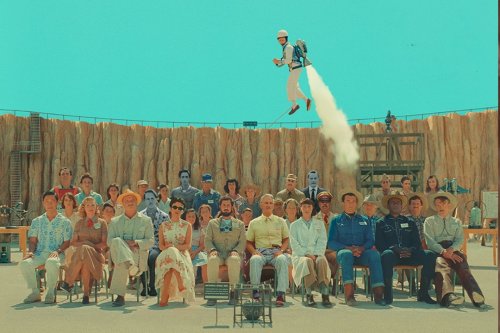A Dissection Of Wes Anderson's Latest Work: Hollow Style And Lack Of Depth

Table of Contents
The Overwhelming Preoccupation with Style
Asteroid City's visual style is undeniably striking. The film is a masterclass in mise-en-scène, boasting perfectly symmetrical compositions, a carefully curated color palette dominated by muted tones and pops of vibrant color, and meticulously designed sets that transport the viewer to a fictional 1950s desert town. This visual storytelling is undeniably captivating, a hallmark of Anderson's distinctive aesthetic. However, this meticulous attention to visual detail often overshadows the narrative and emotional core of the film. The sheer perfection of the visuals can, at times, feel artificial, creating a distance between the viewer and the characters' experiences.
- Excessive use of symmetry detracts from emotional impact. The constant symmetry, while visually pleasing, can feel repetitive and ultimately prevent viewers from fully connecting with the characters' emotional journeys. The rigid structure of the framing seems to mirror the rigid emotional landscape of the film itself.
- Repetitive color palettes become visually monotonous. While the color choices are undeniably beautiful, the consistent use of similar palettes across different scenes can lead to visual monotony, hindering the film's capacity to build emotional tension or create a sense of visual dynamism.
- Stylized sets feel artificial and disconnect viewers from the characters. The meticulously crafted sets, while visually impressive, can feel detached from reality, making it challenging for viewers to truly empathize with the characters' struggles and triumphs. The artificiality of the environment creates a barrier to emotional investment.
Shallow Character Development and Lack of Emotional Connection
While Asteroid City boasts an impressive ensemble cast, the characters themselves feel surprisingly shallow. Their motivations are often unclear, their arcs predictable, and their relationships lack the depth and complexity found in Anderson's earlier works. This lack of emotional depth prevents viewers from forming a genuine connection with the characters, leaving them feeling emotionally uninvolved despite the film's melancholic undertones.
- Characters feel archetypal rather than unique individuals. Many characters inhabit familiar archetypes, lacking the nuance and idiosyncrasies that made characters in films like The Royal Tenenbaums or Moonrise Kingdom so memorable and compelling.
- Lack of genuine emotional development prevents viewer investment. The characters' emotional journeys are underdeveloped, leaving the audience without a strong sense of their inner lives or the transformative power of their experiences.
- Relationships lack authenticity and depth. The relationships between characters often feel superficial, lacking the genuine connection and emotional weight necessary to resonate with viewers.
Repetitive Themes and Lack of Originality
Several recurring themes in Anderson's filmography—nostalgia, childhood, loss, and the complexities of family—are present in Asteroid City. However, these familiar motifs are presented without the fresh perspective or innovative storytelling that characterized his earlier works. The narrative structure feels predictable, lacking the surprising twists and turns that kept viewers engaged in his previous films. This repetition contributes to a sense of creative stagnation, leaving the audience feeling like they've seen this story before.
- Familiar narrative structures lack surprises or twists. The predictable narrative structure reinforces the sense that the film prioritizes style over substance. There are few genuine narrative surprises.
- Themes of loss, nostalgia, and childhood feel cliché. These themes, while powerful, are handled with a lack of originality and depth, resulting in a sense of familiarity that prevents the film from reaching its full emotional potential.
- Lack of risk-taking in storytelling. Asteroid City feels safe, relying on familiar tropes and narrative structures rather than pushing boundaries or exploring new creative territories.
Beyond the Surface: Reassessing Wes Anderson's Creative Vision
Asteroid City, despite its undeniable visual brilliance, ultimately suffers from a lack of narrative depth and emotional resonance. The film's overwhelming preoccupation with style overshadows its substantive elements, resulting in shallow character development, repetitive themes, and a lack of originality. While Anderson's distinctive visual style remains captivating, the question remains whether his focus on aesthetic perfection has come at the expense of genuine emotional connection and innovative storytelling. Can he overcome this perceived creative rut, or will his future films continue to prioritize style over substance?
What are your thoughts on Wes Anderson's latest film? Do you agree that Wes Anderson’s style has become hollow? Discuss the depth (or lack thereof) in Wes Anderson's work. Share your analysis of Wes Anderson's stylistic choices and join the conversation!

Featured Posts
-
 Pacers Games John Haliburtons Presence And Its Significance
May 28, 2025
Pacers Games John Haliburtons Presence And Its Significance
May 28, 2025 -
 Late Match Drama Sinner Survives To Reach Next Round In Paris
May 28, 2025
Late Match Drama Sinner Survives To Reach Next Round In Paris
May 28, 2025 -
 The End Of Rent Freeze Assessing The Risks To Tenants And Housing Quality
May 28, 2025
The End Of Rent Freeze Assessing The Risks To Tenants And Housing Quality
May 28, 2025 -
 South Korea Presidential Election Who Are The Leading Contenders
May 28, 2025
South Korea Presidential Election Who Are The Leading Contenders
May 28, 2025 -
 Trumps Proposed 3 Billion Shift From Harvard Grants To Trade Schools
May 28, 2025
Trumps Proposed 3 Billion Shift From Harvard Grants To Trade Schools
May 28, 2025
Latest Posts
-
 Premiera Singla Flowers Miley Cyrus Co Wiemy O Nowej Plycie
May 31, 2025
Premiera Singla Flowers Miley Cyrus Co Wiemy O Nowej Plycie
May 31, 2025 -
 Flowers Miley Cyrus Recenzja Nowego Singla I Oczekiwania Na Album
May 31, 2025
Flowers Miley Cyrus Recenzja Nowego Singla I Oczekiwania Na Album
May 31, 2025 -
 Analiza Singla Flowers Miley Cyrus Czy To Zapowiedz Wielkiego Powrotu
May 31, 2025
Analiza Singla Flowers Miley Cyrus Czy To Zapowiedz Wielkiego Powrotu
May 31, 2025 -
 Miley Cyrus Wydala Flowers Pierwszy Singiel Z Nadchodzacego Albumu
May 31, 2025
Miley Cyrus Wydala Flowers Pierwszy Singiel Z Nadchodzacego Albumu
May 31, 2025 -
 Flowers Debiutancki Singiel Miley Cyrus Z Nowej Plyty Posluchaj
May 31, 2025
Flowers Debiutancki Singiel Miley Cyrus Z Nowej Plyty Posluchaj
May 31, 2025
